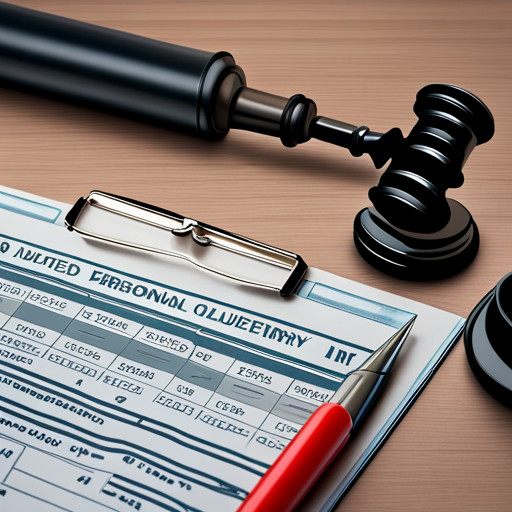Nuisance Value Settlements Getting Payment for a Weak Injury Claim
Understanding the intricacies of nuisance value settlements can be challenging, yet this knowledge is valuable when navigating the complex landscape of insurance claims.

This article delves into the factors determining a nuisance value settlement, the role of insurance adjusters, the potential for claim rejection, and the strategic negotiation of such settlements.
Potential risks associated with threatening lawsuits will also be discussed, providing a comprehensive guide for those interested in this particular aspect of insurance litigation.
Key Takeaways
- Nuisance value settlements are small amounts of money paid by insurance companies to resolve weak injury claims.
- These settlements are offered when there is no proof of liability or when the extent of the victim's damages is doubted.
- Claimants can still pursue a nuisance-value settlement even if their claim has been denied.
- Tactics for negotiating a nuisance settlement include maintaining contact with the adjuster, gathering evidence, considering legal action, and emphasizing the cost of litigation.
Understanding Nuisance Value Settlements

Understanding nuisance value settlements involves recognizing them as modest amounts paid by insurance companies to close out weak injury claims, typically offered when there is insufficient proof of liability or when the adjuster questions the extent of the claimant's damages.
An analytical examination of these settlements unveils several factors affecting settlement amount, including the strength of documentary evidence, the perceived liability, and the extent of the claimed damages.
The role of documentation in nuisance value settlements cannot be understated as this provides the factual basis for any claim. A detail-oriented approach towards collating supporting documents can persuade the adjuster of the claim's validity, thereby enhancing the potential for securing a settlement.
Therefore, a comprehensive understanding of these settlements serves as a potent tool in navigating claim negotiations.
Factors Determining a Nuisance Value Settlement

Several factors come into play in determining the monetary amount offered for minor damage cases. These factors include the strength of evidence, the liability of the insured party, and the perceived seriousness of the alleged damage.
The insurance adjuster's perception of the claimant's readiness and ability to pursue legal action could also influence the settlement amount. Insurance companies often consider the potential cost and duration of litigation, as well as the potential negative publicity, when deciding whether to settle even weak injury claims.
To negotiate effectively, it is important to maintain persistent contact with the adjuster, provide credible evidence, and emphasize the cost-effectiveness of settling over litigating. However, negotiation should always be conducted in good faith. Overplaying one's hand or engaging in unethical tactics could lead to claim rejection.
Overall, understanding the factors that influence settlement amounts and employing effective negotiation strategies can help claimants achieve a fair resolution for their minor damage cases.
The Role of Insurance Adjusters in Nuisance Value Settlements

In the realm of minor damage cases, the role of insurance adjusters is pivotal, as they are responsible for assessing the validity of the claims, determining the liability of the insured party, and deciding on the appropriateness of the monetary compensation. The adjuster's role in evaluating damages is crucial in establishing the degree of liability and the amount of compensation that may be awarded.
1. Evaluation of Damages: Here, the adjuster investigates the claim, examines medical records, and estimates the cost of damages to determine the claim's worth.
2. Decision Making Process: The adjuster's decision-making process involves analyzing the evidence, assessing the claim's validity, and deciding whether to approve or deny the claim.
3. Negotiation: The adjuster negotiates with the claimant to reach a settlement that is agreeable to both parties.
4. Settlement: The adjuster finalizes the settlement, ensuring its implementation and closure.
The Possibility of Claim Rejection

The probability of claim rejection increases when there is insufficient evidence linking the alleged injuries to the incident in question. The examination of potential outcomes reveals that claimants may face denial due to the lack of compelling evidence or the absence of a clear causal relationship between the incident and the injuries. Considering alternative options, such as the presentation of further evidence or consultation with legal professionals, may strengthen the claim and decrease the probability of rejection.
| Factor | Potential Outcome | Alternative Option |
|---|---|---|
| Insufficient Evidence | Increased likelihood of claim rejection | Gather and present additional evidence |
| No Clear Causal Link | Claim rejection due to lack of causality | Seek expert opinion to establish causality |
| Weak Negotiation | Inability to persuade the adjuster leading to rejection | Employ negotiation tactics or legal assistance |
This analytical perspective helps to understand the intricate dynamics of claim rejection and potential strategies to address it.
Effective Strategies for Nuisance Settlement Negotiations

Effective strategies for negotiating minimal compensation claims involve maintaining persistent contact with the adjuster, providing credible evidence, and emphasizing the cost-effectiveness of settling over litigation.
Potential negotiation tactics include:
1. Maintaining consistent communication with the adjuster, demonstrating a commitment to reach a settlement.
2. Collecting and providing substantial evidence to substantiate the claim, thereby increasing its credibility.
3. Highlighting the financial advantages of settling, as litigation can be costly and time-consuming.
4. Seeking legal advice to understand the nuances of the negotiation process and make informed decisions.
The benefits of seeking legal advice include obtaining an objective assessment of the claim's strength, understanding the legal complexities involved, and receiving guidance on effective negotiation tactics.
Thus, a thorough and meticulous approach can potentially result in a successful nuisance settlement negotiation.
Importance of Evidence in Bolstering Your Claim

Evidence plays a crucial role in strengthening personal injury claims, as it can substantiate the extent of damages and establish the liability of the insured party. The importance of documentation in supporting your claim cannot be overstated. It provides tangible proof of injuries, property damage, and other losses, which is invaluable in the negotiation process.
Relevant documents may include medical records, police reports, and receipts for expenses incurred as a result of the injury. Equally significant is the role of witness statements in strengthening your case. These accounts offer an independent, third-party perspective on the incident, corroborating your version of events.
Thus, meticulous documentation and credible witness statements are crucial in fortifying a claim, even one deemed weak initially.
Legal Assistance in Negotiating a Settlement

Legal assistance can play a pivotal role in negotiating a settlement, providing expertise and guidance throughout the process. Personal injury attorneys, in particular, have a significant role in nuisance settlements.
1. They bring legal expertise to the table, ensuring the claimant is aware of their rights and obligations.
2. They are experienced in negotiating with insurance adjusters, which can lead to a more favorable outcome.
3. Their involvement illustrates the claimant's seriousness and readiness to escalate the claim if necessary.
4. They can guide the claimant in gathering compelling evidence to bolster a weak injury claim.
Thus, even in the context of nuisance settlements, the engagement of a personal injury attorney can lend weight to the claimant's position, increasing the likelihood of a satisfactory resolution.
Common Causes for Personal Injury Claim Denial

Common causes for personal injury claim denial include:
- Lack of liability on the part of the insured
- Absence of credible evidence linking the alleged injuries to the incident
Factors that can affect claim denial rates are:
- Discrepancies in the claimant's account of the incident
- Delay in reporting the accident
- Failure to seek immediate medical attention
- Lack of substantial damage to the vehicle involved in the accident
If a claim is denied, necessary steps to take include:
- Thoroughly reviewing the denial letter for specifics
- Gathering additional supporting evidence
- Seeking expert legal advice
It is crucial to maintain open communication with the insurance company and ensure that all relevant details of the incident are accurately presented.
The Significance of Timely Communication With the Insurance Company

Timely communication with the insurance company plays a pivotal role in initiating the claims process and maintaining momentum throughout negotiations. The importance of prompt communication cannot be overstated.
1. Claim Initiation: Early contact allows for immediate initiation of the claim, preventing potential denials due to late reporting.
2. Evidence Gathering: Prompt communication provides the opportunity for a timely gathering and presentation of evidence, thus maximizing compensation with evidence.
3. Negotiation Continuity: Regular interaction helps maintain the flow of negotiation, preventing stagnation of the process.
4. Claim Resolution: Timely and effective communication aids in achieving a faster claim resolution, thus ensuring the claimant's satisfaction.
Risks Associated With Threatening Lawsuits

Threatening to file a lawsuit without substantial grounds may lead to undesirable consequences, including potential loss of credibility in negotiations and the possibility of bearing the defendant's legal fees if the case is lost. It is crucial to weigh the pros and cons of legal action before initiating it.
While litigation might compel an insurance adjuster to consider a nuisance value settlement, it might also result in significant financial losses. Therefore, alternatives to threatening lawsuits should be explored.
These may include persistent negotiation, substantiating the claim with credible evidence, or seeking advice from a personal injury attorney. These strategies can potentially yield the same results as a lawsuit threat, without the associated risks.
Thus, caution must be exercised when considering legal threats as a negotiation strategy.
Pros and Cons of Filing a Lawsuit

In assessing the feasibility of legal action, it is crucial to consider both the potential benefits, such as the possibility of achieving a settlement, and the inherent risks, including financial loss and a potential impact on the claimant's credibility.
The act of filing a lawsuit brings numerous considerations into play:
1. Potential gains: There is the possibility of achieving a settlement or court award that could significantly exceed the initial claim.
2. Financial risks: These include court fees, attorney costs, and potential liability for the defendant's legal expenses if the case is lost.
3. Credibility risks: Unsuccessful lawsuits can negatively impact the claimant's credibility in any future legal actions.
4. Time and effort: The process can be lengthy and complex, requiring substantial commitment and patience.
Using the Cost of Litigation to Your Advantage

Transitioning from the exploration of the advantages and disadvantages associated with filing a lawsuit, the focus now shifts to the strategic utilization of litigation costs as leverage in settlement negotiations.
Leveraging the financial implications linked to court proceedings can be instrumental in maximizing compensation. Comprehending the potential litigation costs, insurance adjusters may be more inclined to consider a settlement, even if it is for nuisance value, to avoid the expense and time inefficiency of court proceedings.
It is in these instances that using legal representation may prove beneficial. Expert legal counsel not only augments the credibility of the claim but also communicates the claimant's preparedness to take the matter to court if necessary, thereby potentially influencing the adjuster's decision in favor of a settlement.
Frequently Asked Questions
What Is the Average Amount Typically Paid Out in a Nuisance Value Settlement?
The quantification of a nuisance value settlement varies widely due to the unique circumstances surrounding each case. While a definitive average is elusive, it is typical for these settlements to range from a few hundred to a few thousand dollars.
Factors such as settlement taxation and the potential for claim rejection can significantly influence these figures. Therefore, understanding these elements is paramount for effective negotiation and realistic expectation management.
How Long Does It Usually Take to Negotiate and Settle a Nuisance Value Claim?
The duration to negotiate and settle a nuisance value claim varies considerably. Factors influencing this period encompass the claim's complexity, the parties' negotiation skills, and the insurance company's responsiveness.
Claimant strategies can expedite the process, such as presenting compelling evidence or emphasizing potential litigation costs. The settlement process, however, requires patience and persistence, as insurance companies may initially resist nuisance value settlements.
Therefore, a definitive timeline remains elusive due to these varying factors.
Are There Specific Types of Injuries That Are More Likely to Result in a Nuisance Value Settlement?
Injuries yielding nuisance value settlements often exhibit minor physical harm or subjective symptoms lacking concrete medical evidence. The role of injury documentation is crucial as it substantiates the claim, despite its minor nature.
During insurance negotiations, the claimant's persistence, reasonable evidence of liability, and portrayal of potential litigation costs may persuade adjusters to settle. However, it remains vital to acknowledge that these settlements are not assured and depend heavily on the adjuster's evaluation of the claim's merit.
Can a Claimant Who Has Previously Accepted a Nuisance Value Settlement File a New Claim if Their Injuries Worsen Over Time?
In accordance with the principles of Claimant's Rights, once a settlement agreement is reached and formalized, the claimant typically forfeits the right to file a new claim for the same injury. This includes situations where injuries worsen over time.
Settlement Limitations are stipulated in the agreement, which is legally binding. Thus, the prognosis of the injury should be thoroughly considered before accepting any settlement, as subsequent deterioration may not be grounds for additional compensation.
What Are Some Examples of Successful Nuisance Value Settlements?
Examples of successful nuisance value settlements are not typically disclosed due to confidentiality clauses in settlement agreements.
However, key components in these cases often involve effective settlement negotiation strategies, including diligent communication with the adjuster and presentation of compelling evidence.
Legal implications of nuisance settlements can include closure of the claim, barring future litigation on the same matter.
Understanding these aspects can assist in strategizing a successful outcome in a nuisance value settlement negotiation.

This post has been generated by AI and was not reviewed by editors. This is Not legal advice. Please consult with an attorney.




